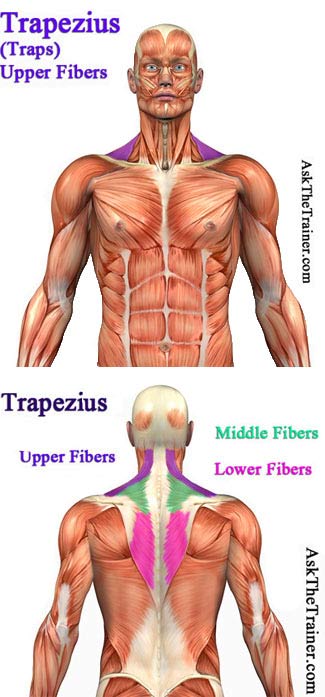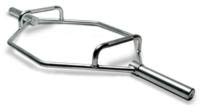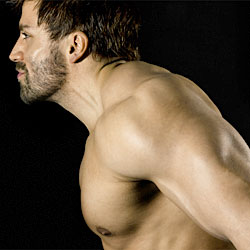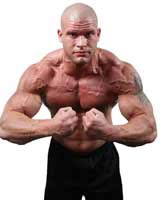- Like
- SHARE
- Digg
- Del
- Tumblr
- VKontakte
- Flattr
- Buffer
- Love This
- Save
- Odnoklassniki
- Meneame
- Blogger
- Amazon
- Yahoo Mail
- Gmail
- AOL
- Newsvine
- HackerNews
- Evernote
- MySpace
- Mail.ru
- Viadeo
- Line
- Comments
- Yummly
- SMS
- Viber
- Telegram
- JOIN
- Skype
- Facebook Messenger
- Kakao
- LiveJournal
- Yammer
- Edgar
- Fintel
- Mix
- Instapaper
- Copy Link
Complete Your Physique With The Best Traps Exercise
Traps Exercises are for Two Different Goals
Goal #1 – Increase Size of the Trapezius Muscle
The traps rest at the top of the pyramid when it comes to your physique. A muscular trapezius is a great way to tell a weight lifter from somebody who does not lift.
If you increase the size of your traps, it will also increase the size of your neck (just in case you’re tired of being called “pencil neck”).
Even though many different exercises involve the upper traps, isolation exercises are usually better for hypertrophy (size increase) of any muscle, including the traps.
Goal #2 – Increase Traps Strength
Traps strength and power is important for performance in many lifts and sports. The shrug is very important to all Olympic lifts. During the second pull of the power clean and power snatch, your traps have to help accelerate the speed on the bar which is needed complete the lift.
While many consider the trapezius to be an underrated muscle, bodybuilders work hard to perfect the top of their shoulders and upper back for contests where they show them off with muscular poses.
To Help You Master the Best Traps Exercises, Here is a Crash Course in Basic Anatomy of the Traps
The Three-Part Trapezius Muscle Has Many Actions

Upper Trapezius
When people talk about “traps”, they are usually referring to the upper trapezius. The best traps exercise focuses on the upper traps because the middle and lower fibers get a good workout during back exercises.
The upper traps are responsible for shoulder elevation, which is the motion of shrugging your shoulders.
The upper traps also assist most movements of the head at the neck. Posture problems such as forward head posture can cause a chronically a tight upper trapezius.
Chronically tight upper traps can lead to headaches and neck pain because of the constant tension. If you have forward head posture the best traps exercise may not be right for you as you already have excessive tension in the traps. You should probably avoid exercises which target the upper traps if you have this particular posture distortion.
Middle & Lower Trapezius
The middle and lower traps are primarily active in back exercises such as rows. The middle and lower traps are partly responsible for the important motion of scapular adduction or retraction, along with the rhomboids. The rhomboids are not visible on the following anatomy drawing because they are located deep to the traps.
Deep means they are closer to the center of the body compared to the superficial or outer trapezius. Retraction is important because squeezing the shoulder blades together stabilizes the shoulders, putting your body in proper biomechanical alignment.
If you maintain proper dynamic posture during all exercises, you will be able to perform each exercise optimally. You will get the best performance, functional strength and aesthetic results if you make sure to optimize your posture.
The Best Traps Exercises for Isolating the Traps
Shoulder Shrugs
There is one and only one exercise which completely isolates the traps. Shrugs are an easy and effective exercise which can be done using a variety of different resistances.
Start: Hold the handles of whatever resistance you choose to use as close to your center of gravity as possible. If you have dumbbells you should hold them at your sides.
Contract your glutes and keep your core tight. Make sure your shoulder blades are retracted, not rounded forward.
Begin the motion: Lift your shoulder blades straight up as high as you can as if you are trying to touch your shoulders to your ears.

Make sure you keep your arms completely straight. Hold for a split second when your shoulders reach the highest point.
Lower under control and repeat. Try not to use your legs or lower back to create momentum.
Modifications: You can perform the shrug with any form of resistance. Examples include dumbbells, barbell, trap bar (picture on left), and low cables.
Upright Row
The upright row is not for everybody. If you have any sort of shoulder issues, it is a good idea to avoid upright rows. If your shoulders are properly mobile and pain-free, the upright row is one of the best traps exercises, as well as a great exercise for your deltoid muscles.
Start: Hold weights close to your center of gravity. Draw in your core and take a deep breath.
Begin the motion: Keep your core drawn in and glutes tight to avoid using your lower back. Retract your shoulder blades and pull the weight up towards your chin.
Make sure you lead with your elbows with your hands trailing. At the top part of the motion your elbows should be at around the same level as your ears. Exhale as you lower the weight back to starting position.
Modifications: You can perform upright row with dumbbells, a barbell, an EZ curl bar or low cables. Again, if you have injury prone shoulders, bad wrists, or any posture problems, the upright row is probably not the best choice of exercise for your traps. Stick to shrugs instead.
The Best Traps Exercises for Developing Power and Strength
High Pulls
High Pulls are the second pull of the power clean. The traps are the first part of the second pull, which helps generate the momentum needed to lift a heavier weight than you can lift under control into the position to catch the weight.
Even though Olympic lifts such as the power clean are not used by many people outside athletics, high pulls can be a great exercise to really work the upper traps. For most people, explosive high pulls are less stressful on the shoulder joints than upright row.
Start: You can start with the weights on the floor if you want to perform the full high pull. You can also start with the weights in the low hang position (around your legs). Your grip should be slightly wider than shoulder width.
Begin the motion: Bend your knees slightly and explosively pull the weight straight up in the air. You should lead with your elbows, raising them as high as they can go.
This means the bar will stop just below your chin. Lower the weight under control and repeat. The explosive energy you use to lift the weights should come from your feet and be transferred all the way into your traps.
Modifications: You can perform high pulls with dumbbells or a barbell.
Dead Lifts
Dead lifts are not just for your legs. Since you’re using a heavier weight than most traps exercises, your traps work hard to hold the weight. All exercises in which you hold a weight will work your traps. Another good example is dumbbell squats, which are basically a dumbbell dead lift.
You can even perform a power shrug at the end to get a really intense contraction of the traps.
Start: Take a slightly wider-than-shoulder-width stance. Grip the barbell with either an overhand or alternating grip. As you set up for the dead lift, sit back until your butt is pretty low.
It is very important to keep your back flat for the entire motion. Never let your shoulders protract (round forward). Keep them retracted back and down as if you are trying to pinch a quarter between them. Keep your arms straight for the entire motion.
Stabilize your core and support your lower back as you take a deep breath and hold it until the weight is pulled all the way up.
Begin the motion: Keep your core tightly drawn in for the duration of the dead lift. Drive up with your chest. Pull the weight straight up. Make sure to keep it as close to your body as you can.
At the top of the motion after you contract your glutes (squeeze your butt) and retract your shoulders you can perform a power shrug before you lower the weight all way back to the floor.
Which Workout Day Should You Do the Best Traps Exercise ?
Which Day You Should Perform Traps Exercises Depends on Your Goals
If you want to increase the size of your traps, you can exercise them 2 or 3 times per week. If you have a day set up only for shoulders, you can perform the best traps exercise after your shoulder presses. You can also perform traps exercises while you exercise other muscle groups.
If you are doing the best traps exercises for maintenance, one day per week is enough. The traps are one of the few body parts that can be exercised with pretty much any other muscle group.
If you have set up your weight training split to include a push day and a pull day, the best traps exercises fit in better with the pulling exercises. Some people even do the best traps exercise on legs day before squats. They claim that the muscle pump in the traps makes it more comfortable for the bar to rest on their shoulders.
Where Can You Find More Exercise Information to Complement the Best Traps Exercises?
- Blast the Traps with Effective Shoulder Exercises – The best traps exercise for you may be compound movements of the shoulders.
- Videos of Many Trapezius Strengthening Exercises – Exercise videos of the best traps exercises and verbal instructions on how to do them properly.
- Most Complete Full Shoulder Workout – A step-by-step workout which includes the best combination of shoulder exercises to build and strengthen your deltoids, traps, and rotator cuff muscles.
- 3 Simple Shoulder Exercises to Prevent Injury – Learn how to avoid common shoulder injuries with these key shoulder workouts.
- Most Important Facts and Tips for Building Muscle – The real facts about muscle building and doing it properly.
- Best Neck Building Exercises – If you have ever wondered how some guys achieve neck growth that can rival that of a tree trunk, then you will want to read on….
About Michael Behnken
Mike Behnken is a personal trainer who holds multiple NASM certifications and a MS in Exercise Science. Mike loves fitness, travel, and photography among many other interests.


